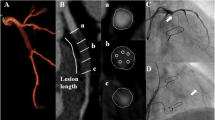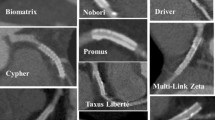Abstract
Objectives
To evaluate the diagnostic accuracy of Mehran’s in-stent restenosis (ISR) classification by coronary computed angiography (CCTA), with reference to invasive coronary angiography (ICA).
Methods
Consecutive symptomatic patients, who had clinically suspected ISR and implanted stent diameter ≥ 3 mm, were prospectively enrolled in our study. Mehran’s classification was employed by CCTA and ICA to classify ISR lesions into four subtypes: focal, diffuse intrastent, diffuse proliferative and total occlusion. CCTA and ICA measurement of lesion length was further compared.
Results
Sixty-one patients with 101 implanted stents were included in our study. The overall sensitivity, specificity, PPV and NPV of CCTA diagnosis of binary ISR, as shown by patient-based analysis (n = 61), were 100 % (49/49), 75 % (8/12), 92.45 % (49/53) and 100 % (8/8) respectively. Mehran’s classification of CCTA correlated well with ICA findings. The diagnostic accuracy of CCTA for class I, class II, class III and class IV lesions was 92.5 %, 91.67 %, 100 % and 100 % respectively. Lesion length was assessed to be significantly longer with CCTA than with ICA (11.03 ± 5.89 mm versus 8.56 ± 4.99 mm, P < 0.001).
Conclusions
Angiographic patterns of in-stent restenosis can be accurately classified by coronary computed angiography. The lesion length measured by CCTA is longer than that assessed by invasive coronary angiography
Key Points
• Patterns of in-stent restenosis can be accurately classified by coronary computed angiography.
• Lesion length appears longer on CCTA than on invasive coronary angiography.
• Stent occlusion is better delineated by coronary computed angiography.
• Optimal treatment can be planned pre-operatively based on CCTA evaluation.




Similar content being viewed by others
Abbreviations
- CCTA:
-
coronary computed tomography angiography
- CPR:
-
curved planar reformation
- DES:
-
drug-eluting stent
- ICA:
-
invasive coronary angiography
- ISR:
-
in-stent restenosis
- IVUS:
-
intravascular ultrasound
- PCI:
-
percutaneous coronary intervention
- QCA:
-
quantitative coronary angiography
- TIMI:
-
thrombolysis in myocardial infarction
- TLR:
-
target-lesion revascularisation
References
Sousa JE, Serruys PW, Costa MA (2003) New frontiers in cardiology: drug-eluting stents: Part I. Circulation 107:2274–2279
Sousa JE, Serruys PW, Costa MA (2003) New frontiers in cardiology: drug-eluting stents: Part II. Circulation 107:2283–2289
Moses JW, Leon MB, Popma JJ et al (2003) SIRIUS Investigators. Sirolimus-eluting stents versus standard stents in patients with stenosis in a native coronary artery. N Engl J Med 349:1315–1323
Stone GW, Ellis SG, Cox DA et al (2004) TAXUS-IV Investigators. A polymer-based, paclitaxel-eluting stent in patients with coronary artery disease. N Engl J Med 350:221–231
Mehran R, Dangas G, Abizaid AS et al (1999) Angiographic patterns of in-stent restenosis: classification and implications for long-term outcome. Circulation 100:1872–1878
Ehara M, Surmely JF, Kawai M et al (2006) Diagnostic accuracy of 64-slice computed tomography for detecting angiographically significant coronary artery stenosis in an unselected consecutive patient population: comparison with conventional invasive angiography. Circ J 70:564–571
Ehara M, Kawai M, Surmely JF et al (2007) Diagnostic accuracy of coronary in-stent restenosis using 64-slice computed tomography: Comparison with invasive coronary angiography. J Am Coll Cardiol 49:951–959
Rist C, von Ziegler F, Nikolaou K et al (2006) Assessment of coronary artery stent patency and restenosis using 64-slice computed tomography. Acad Radiol 13:1465–1473
Rixe J, Achenbach S, Ropers D et al (2006) Assessment of coronary artery stent restenosis by 64-slice multi-detector computed tomography. Eur Heart J 27:2567–2572
Cademartiri F, Schuijf JD, Pugliese F et al (2007) Usefulness of 64-slice multislice computed tomography coronary angiography to assess in-stent restenosis. J Am Coll Cardiol 49:2204–2210
Oncel D, Oncel G, Karaca M (2007) Coronary stent patency and in-stent restenosis: determination with 64-section multidetector CT coronary angiography-initial experience. Radiology 242:403–408
Zhang J, Li M, Lu Z, Hang J, Pan J, Sun L (2012) In vivo evaluation of stent patency by 64-slice multidetector CT coronary angiography: shall we do it or not? Int J Cardiovasc Imaging 28:651–658
Andreini D, Pontone G, Mushtaq S, Pepi M, Bartorelli AL (2010) Multidetector computed tomography coronary angiography for the assessment of coronary in-stent restenosis. Am J Cardiol 105:645–655
Carrabba N, Schuijf JD, de Graaf FR et al (2010) Diagnostic accuracy of 64-slice computed tomography coronary angiography for the detection of in-stent restenosis: a meta-analysis. J Nucl Cardiol 17:470–478
Amant C, Bauters C, Bodart JC et al (1997) D allele of the angiotensin I-converting enzyme is a major risk factor for restenosis after coronary stenting. Circulation 96:56–60
Solinas E, Dangas G, Kirtane AJ et al (2008) Angiographic patterns of drug-eluting stent restenosis and one-year outcomes after treatment with repeated percutaneous coronary intervention. Am J Cardiol 102:311–315
Steinberg DH, Gaglia MA Jr, Pinto Slottow TL et al (2009) Outcome differences with the use of drug-eluting stents for the treatment of in-stent restenosis of bare-metal stents versus drug-eluting stents. Am J Cardio 103:491–495
Rathore S, Kinoshita Y, Terashima M et al (2010) A comparison of clinical presentations, angiographic patterns and outcomes of in-stent restenosis between bare metal stents and drug eluting stents. EuroIntervention 5:841–846
Mishkel GJ, Moore AL, Markwell S, Shelton MC, Shelton ME (2007) Long-term outcomes after management of restenosis or thrombosis of drug-eluting stents. J Am Coll Cardiol 49:181–184
Mintz GS, Painter JA, Pichard AD et al (1995) Atherosclerosis in angiographically “normal” coronary artery reference segments: an intravascular ultrasound study with clinical correlations. J Am Coll Cardiol 25:1479–1485
Yamagishi M, Hosokawa H, Saito S et al (2002) Coronary disease morphology and distribution determined by quantitative angiography and intravascular ultrasound-reevaluation in a cooperative multicenter intravascular ultrasound study (COMIUS). Circ J 66:735–740
van Velzen JE, de Graaf MA, Ciarka A et al (2012) Non-invasive assessment of atherosclerotic coronary lesion length using multidetector computed tomography angiography: comparison to quantitative coronary angiography. Int J Cardiovasc Imaging. doi:10.1007/s10554-012-0015-7
Virmani R, Burke AP, Kolodgie FD, Farb A (2003) Pathology of the thin-cap fibroatheroma: a type of vulnerable plaque. J Interv Cardiol 16:267–272
Okabe T, Mintz GS, Buch AN et al (2007) Intravascular ultrasound parameters associated with stent thrombosis after drug-eluting stent deployment. Am J Cardiol 100:615–620
Di Mario C, Görge G, Peters R et al (1998) Clinical application and image interpretation in intracoronary ultrasound. Study Group on Intracoronary Imaging of the Working Group of Coronary Circulation and of the Subgroup on Intravascular Ultrasound of the Working Group of Echocardiography of the European Society of Cardiology. Eur Heart J 19:207–229
Mintz GS, Nissen SE, Anderson WD et al (2001) American College of Cardiology Clinical Expert Consensus Document on Standards for Acquisition, Measurement and Reporting of Intravascular Ultrasound Studies (IVUS). A report of the American College of Cardiology Task Force on Clinical Expert Consensus Documents. J Am Coll Cardiol 37:1478–1492
Hang CL, Lee YW, Guo GB et al (2011) Evaluation of coronary artery stent patency by using 64-slice multi-detector computed tomography and conventional coronary angiography: A comparison with intravascular ultrasonography. Int J Cardiol http://dx.doi.org/10.1016/j.ijcard.2011.10.003
Acknowledgements
This study is not supported by any grants. Dr. Zhigang Lu contributed significantly to the initial case collection, performing invasive coronary angiography and preparing the manuscript. Thus, all of the authors agree that he deserves to be the co-first author of this manuscript.
Conflicts of interest
There are no conflicts of interest.
Author information
Authors and Affiliations
Corresponding author
Rights and permissions
About this article
Cite this article
Pan, J., Lu, Z., Zhang, J. et al. Angiographic patterns of in-stent restenosis classified by computed tomography in patients with drug-eluting stents: correlation with invasive coronary angiography. Eur Radiol 23, 101–107 (2013). https://doi.org/10.1007/s00330-012-2559-2
Received:
Revised:
Accepted:
Published:
Issue Date:
DOI: https://doi.org/10.1007/s00330-012-2559-2




